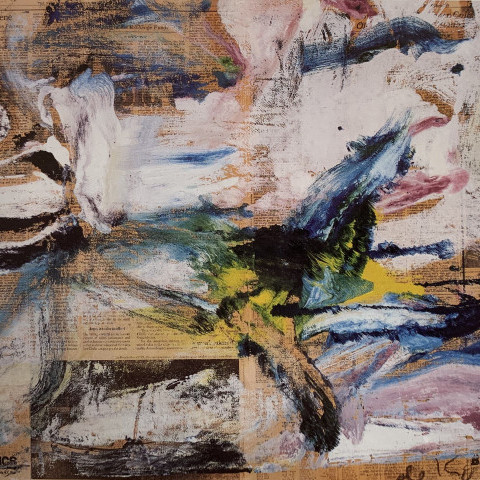Willem de Kooning was born in Rotterdam, Holland on April 24, 1904. His father, Leenert, was a wine and beer distributor who won custody of young Willem when his parents separated about five years after his birth. His mother, Cornelia Nobel de Kooning, ran a tough seamen's bar, and snatched the boy back soon after. At the age of twelve, with elementary school behind him, de Kooning entered an informal apprenticeship with commercial artists and designers, Jan and Jaay Gidding, who also provided his art education. They enrolled him in night courses at the Rotterdam Akademie voor Beeldende Kunsten en Wettenschappen, where he studied academic art and crafts. His first jobs were in commercial art, including a year in Belgium during which he visited museums and studied.
He came to the United States illegally in 1926 and settled in Hoboken, New Jersey, which had a large Dutch community, while he learned English. He began his career as a house painter. When he saw an ad in a New York newspaper for someone to do commercial artwork, he went to New York and for many years he did lettering, sign painting and carpentry. In 1935 he was employed doing murals for the Federal Arts project; the same year he did his first easel painting and his first independent commission was for part of a mural for the New York World's Fair of 1939 and 1940. A series of black and white abstractions in the late 1940s were the subject of his first one-man show. He chose black and white for the simple reason that the neutral paints were less expensive, but the works were considered his best by many experts. In 1943 he married Elaine Fried, who was one of his art students. In 1948 they visited East Hampton as weekend guests of Jackson Pollock and Lee Krasner.
`
De Kooning's pride and joy was his studio, built between 1963 and 1969 to his specifications. He spent most of his day there. Besides hard work, his other pleasures were seeing movies and bicycle riding. He designed the huge studio with 30-foot ceilings, white walls and large expanses of glass, allowing all available light to pour in.
Despite his quick American assimilation, de Kooning's ties to Holland surfaced on occasion. It is significant that though in 1964 de Kooning was awarded America's highest civilian award, the Medal of Freedom, he had remained a Dutch citizen for almost forty years after arriving here.
The whole myth of American life, the vulgarity, the bigness, the overstatements, appealed to De Kooning. He could find inspiration in aspects of American culture that Americans tend to be repulsed by. He repeatedly told visitors that he had gotten the idea of mixing his colors from the ice-cream counter at Howard Johnson's, where twenty-eight variously colored flavors were shown off in buckets.
Like many artists, De Kooning had frequent periods of self-doubt while painting. A doctor friend told him to take a brandy in the morning; as a result, he became a drunk. His alcoholism contributed to the disintegration of his marriage and they separated in 1955. They never divorced and she remained his close friend and colleague. After the separation, DeKooning, who was always attractive to women, moved in with Joan Ward, a commercial artist. When De Kooning was fifty-two, their daughter, Lisa, was born. Three years later deKooning moved to Rome with Ruth Kligman, an artist's model. But his alcoholic blackouts grew worse, interspersed with periods in drying-out wards, until 1978 when Elaine finally persuaded him to go to Alcoholics Anonymous. She secretly gave him a drug, Antabuse, that made him sick when he drank. By 1980 he was through the worst. The originator of a boisterous idea of painting-as-adventure, he had gotten lost in a haze of often violent alcoholism and was almost never able to paint. The period between 1978 and 1981 in a retrospective at the National Gallery of Art was represented by a single work. In the 1980s, however, a newly sober De Kooning suddenly became productive once again, although he also began to slide into what the doctors believe is Alzheimer's disease.
De Kooning used a variety of tricks to pump up the sensuously inviting tactility of his surfaces, including his famous wet-on-wet technique of mixing salad oil in the pigment, in order to make it slithery, fluid and receptive to sustained periods of work. It didn't dry out fast. As he worked he would repeatedly scrape down the surface, leaving layered smears and traces of underpaint to show through, like insistent memories of past encounters piling up one on top of the other. His paintings can look slatternly, as if they've been around. He rarely painted either males or reclining figures.
De Kooning's circle of friends consisted either of old acquaintances of many years' duration or people introduced to him by a trusted group of advisors who shielded him from exploitation. In this second category is former Beatle, Paul McCartney, whose wife, Linda Eastman, was the daughter of De Kooning's lawyer, Lee Eastman. The McCartneys always came to visit when they were in East Hampton.
Great artists have collided with mortality throughout history, but none has done it in quite the way that De Kooning has. His last paintings were those made between 1981 and 1990; then he laid down his brushes for good and became an invalid tended around the clock. He died on Wednesday, March 19, 1997.
Source: askart.com

